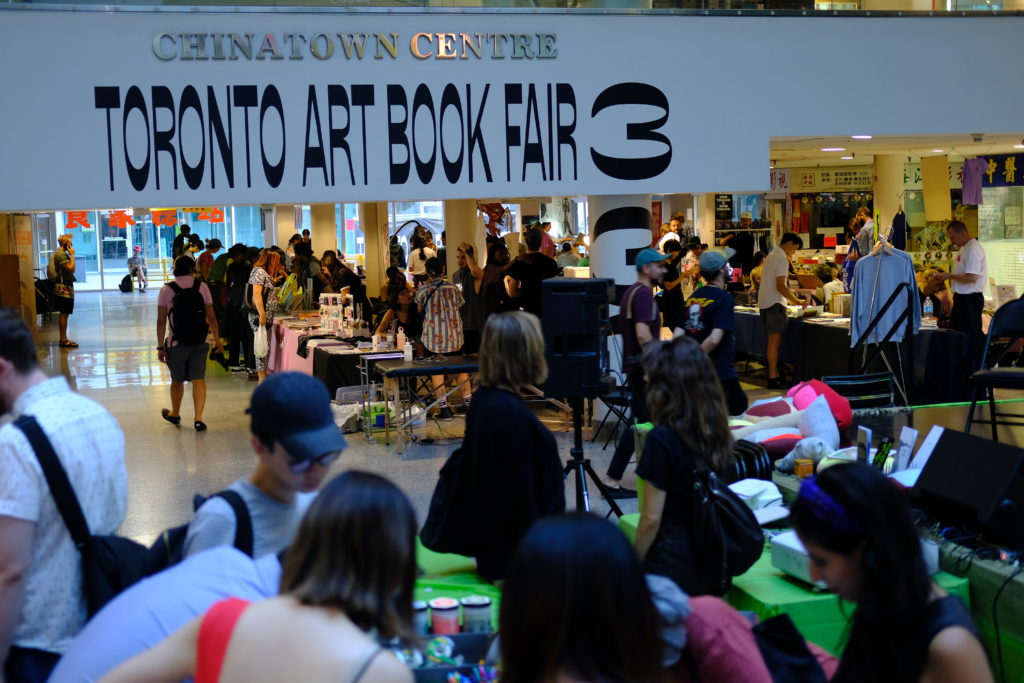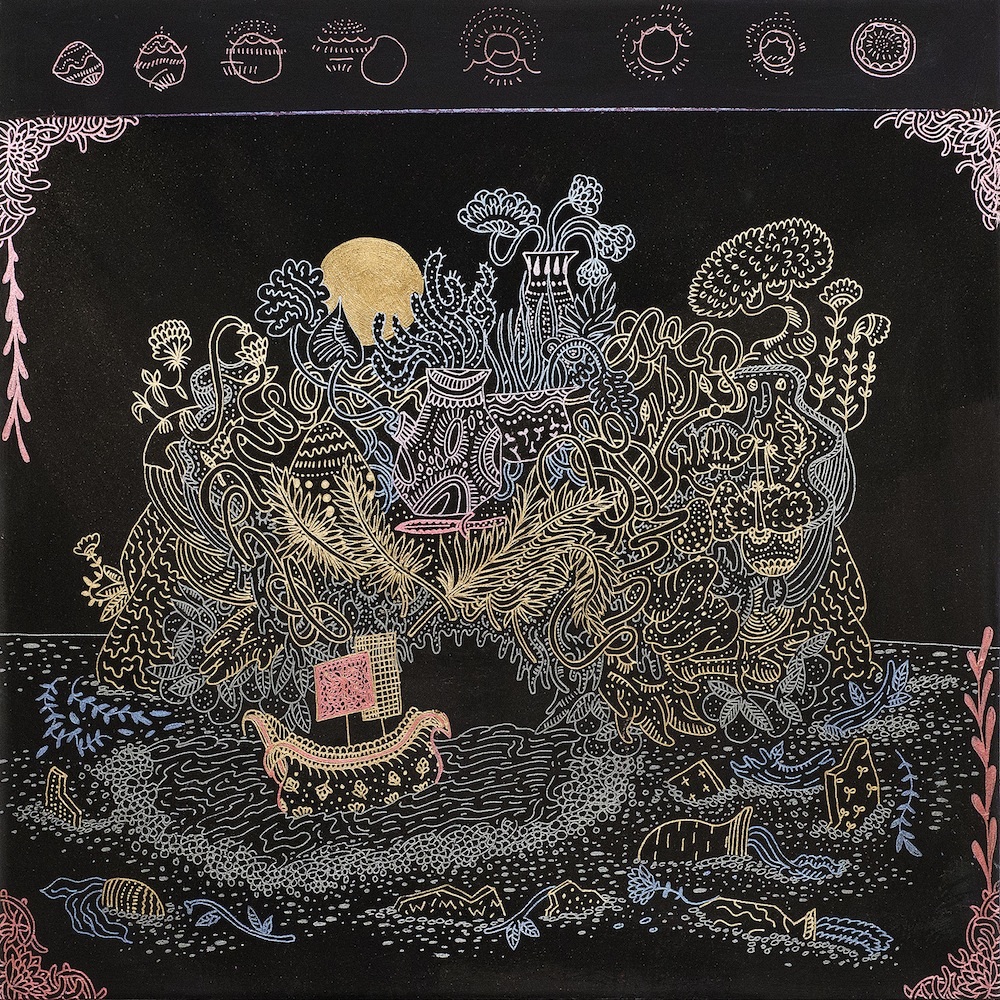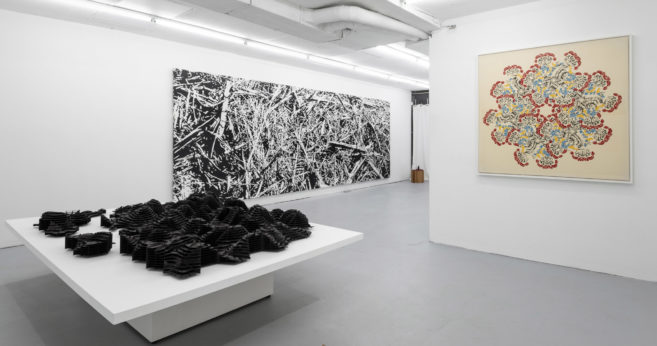This year, the Toronto Art Book Fair (TOABF) launched its third annual exposition in a new venue: Chinatown Centre Mall in the downtown core. The four-day fair operated in conjunction with Toronto Art Book Week, which showcased a program of over 300 Canadian artists and exhibitors involved in workshops, artist talks and exhibitions. Art Metropole played an integral role in developing this year’s programming as TOABF’s Principal Curatorial Partner.
Approaching the lower concourse level of Chinatown Centre Mall, I encountered a bustling hub of artists and authors; it was my first visit to the Toronto Art Book Fair. I knew right away that the fair was a safe space for creative and critical minds, one that allowed us to be witness to society’s unbalanced systems and question the ways we can challenge them in order to create a more inclusive worldview—through artist-led publishing.
A main stage area was set-up in the mall’s brightly lit, four-storey apex as the rows of vendors extended across the lower level, sandwiched between essential Chinatown Centre stores conducting regular business. Table upon table displayed pins, pens, patches, prints, shirts, zines, art books, keychains, magazines, colouring books, cards, notebooks, etc. I was in gift heaven, but for myself.
Unexpectedly, there were also live tattoo sessions happening on-site with tattoo artist Lee, also known as Rat666tat, who displayed a variety of flash designs that were available immediately. These designs varied in message, though my favourite was a tombstone with the lettering “GENDER,” implying that the notion of gender is, indeed, dead. I considered signing up as my eyes wandered over to Prefix Photo’s table where I saw Milk and Melancholy by Kenneth Hayes, which I later learned is the first book on the use of milk in art. I was pleased to see Born in the North, a design duo of twin brothers, Christopher and Gregory Mitchell, whose work is inspired by their Mi’kmaq ancestry. Their iron-on patches are a personal favourite of mine, especially the ones that featured the medicine wheel, an important symbol of Indigenous ways of knowing. Delicate booklets by Annie Wong were at MICE Magazine’s table while Milkweed Zine proudly displayed their sex-positive feminist magazine.
Among this sea of books and artworks, crowds of people sat off to the side, occasionally clapping and cheering for the quarter-finals of the FIFA 2018 World Cup on a large-screen TV. The mix of artworks, artists and casual soccer fans was odd but perfect, as it seemed to mirror some of the quirky narratives found within.
A captivating panel discussion took place on the main stage between local artists Maanii Oakes, sab meynert and Steven Beckly, moderated by Henry Heng Lu. They began with a territorial acknowledgement but then recognized that, although this has become an institutional standard, acknowledgement is only the beginning of elevating Indigenous voices. Each artist discussed notions of community and how their practices facilitate collaborative, reciprocal relationships. Because both Oakes and meynert work in the realm of tattooing, they acknowledged the importance of ceremony and the responsibility of maintaining meaningful connections through their practices. “I’m not interested in the colonial gaze that has been put on our bodies–it took the context of land out of the work. Marking our bodies on the land is a way of reclaiming land,” said Oakes. Beckly discussed his participation in New Ho Queen, a collective of artists and DJs who promote queer Asian voices and create safe social spaces to come together without feeling fetishized. This conversation felt integral for contemporary artists who engage with community building through their practices, to produce resistance and solidarity.
Elsewhere, I shook hands with conceptual artist and curator Micah Lexier, who was sitting beside the Halifax Ink table; he cheekily offered to sell me a paper-punched hole as a collaborative design. This personal experience made me appreciate what the Toronto Art Book Fair embodies: a space liberated from the notion that the artist’s experience should be different from the viewer’s. Why the necessity to divide makers from observers? Why do we feel the need to idolize phantom artists? The Toronto Art Book Fair offered a communal gathering space, outside the gallery system, for imaginative and analytical voices to be heard. It showcased artworks by thinkers and makers and provided a platform for relevant conversations around publishing, and politics.
 View of Toronto Art Book Fair at Chinatown Centre Mall. Photo: Milena Chevillard
View of Toronto Art Book Fair at Chinatown Centre Mall. Photo: Milena Chevillard

 sab meynert, CROSSING THE THRESHOLD, ENTERING ANEW, 2014. Gouache, ink, brass dust on paper, 25,4 x 25.4 cm.
sab meynert, CROSSING THE THRESHOLD, ENTERING ANEW, 2014. Gouache, ink, brass dust on paper, 25,4 x 25.4 cm.






